Articles
- Page Path
- HOME > J Musculoskelet Trauma > Volume 26(3); 2013 > Article
-
Original Article
- Arthroscopic Assisted Intra-Articular Reduction and Internal Fixation of Tibia Plateau Fracture
- Dong Hwi Kim, M.D., Gwang Chul Lee, M.D., Kwi Youn Choi, M.D., Sung Won Cho, M.D., Sang Ho Ha, M.D.
-
Journal of the Korean Fracture Society 2013;26(3):191-198.
DOI: https://doi.org/10.12671/jkfs.2013.26.3.191
Published online: July 15, 2013
Department of Orthopaedic Surgery, School of Medicine, Chosun University, Gwangju, Korea.
- Address reprint requests to: Gwang Chul Lee, M.D. Department of Orthopaedic Surgery, Chosun University Hospital, 365 Pilmun-daero, Dong-gu, Gwangju 501-717, Korea. Tel: 82-62-220-3147, Fax: 82-62-226-3379, leekci@chosun.ac.kr
Copyright © 2013 The Korean Fracture Society. All rights reserved.
This is anOpen Access article distributed under the terms of the Creative Commons Attribution Non-Commercial License (http://creativecommons.org/licenses/by-nc/3.0/) which permits unrestricted non-commercial use, distribution, and reproduction in any medium, provided the original work is properly cited.
- 434 Views
- 4 Download
- 1 Crossref
Abstract
-
Purpose
- We evaluated the results of arthroscopic intra-articular reduction and internal fixation of tibial plateau fractures without cortical window along with any additional bone grafts.
-
Materials and Methods
- From March 2006 to March 2009, twelve patients with arthroscopic intra-articular reduction and internal fixation of tibial plateau fractures over 5 mm in depression and displacement on the articular surface in computed tomography (CT) were enrolled in this study. We reduced or removed the depressed fracture fragment using freer without making a cortical window. Then, we accomplished internal fixation by a cannulated screw. All cases have not received bone graft. Both the postoperative clinical and radiological results were evaluated by the Rasmussen system.
-
Results
- The fractures were healed completely in an average of 9 (range from 7 to 12) weeks. According to Rasmussen classification, we obtained satisfactory clinical results as excellent in 8 cases, good in 3 cases, and fair in 1 case; and radiological results were excellent in 7 cases and good in 5 cases.
-
Conclusion
- We consider that arthroscopic intra-articular reduction and internal fixation of tibial plateau fractures without cortical window and any additional bone grafts is are a useful methods for attaining satisfactory results.
- 1. Asik M, Cetik O, Talu U, Sozen YV. Arthroscopy-assisted operative management of tibial plateau fractures. Knee Surg Sports Traumatol Arthrosc, 2002;10:364-370.ArticlePDF
- 2. Bernfeld B, Kligman M, Roffman M. Arthroscopic assistance for unselected tibial plateau fractures. Arthroscopy, 1996;12:598-602.Article
- 3. Buchko GM, Johnson DH. Arthroscopy assisted operative management of tibial plateau fractures. Clin Orthop Relat Res, 1996;(332):29-36.Article
- 4. Caspari RB, Hutton PM, Whipple TL, Meyers JF. The role of arthroscopy in the management of tibial plateau fractures. Arthroscopy, 1985;1:76-82.Article
- 5. Chan YS, Chiu CH, Lo YP, et al. Arthroscopy-assisted surgery for tibial plateau fractures: 2- to 10-year follow-up results. Arthroscopy, 2008;24:760-768.Article
- 6. Delamarter R, Hohl M. The cast brace and tibial plateau fractures. Clin Orthop Relat Res, 1989;(242):26-31.Article
- 7. Fowble CD, Zimmer JW, Schepsis AA. The role of arthroscopy in the assessment and treatment of tibial plateau fractures. Arthroscopy, 1993;9:584-590.Article
- 8. Gausewitz S, Hohl M. The significance of early motion in the treatment of tibial plateau fractures. Clin Orthop Relat Res, 1986;(202):135-138.Article
- 9. Guanche CA, Markman AW. Arthroscopic management of tibial plateau fractures. Arthroscopy, 1993;9:467-471.Article
- 10. Holzach P, Matter P, Minter J. Arthroscopically assisted treatment of lateral tibial plateau fractures in skiers: use of a cannulated reduction system. J Orthop Trauma, 1994;8:273-281.
- 11. Honkonen SE. Indications for surgical treatment of tibial condyle fractures. Clin Orthop Relat Res, 1994;(302):199-205.Article
- 12. Honkonen SE. Degenerative arthritis after tibial plateau fractures. J Orthop Trauma, 1995;9:273-277.Article
- 13. Jennings JE. Arthroscopic management of tibial plateau fractures. Arthroscopy, 1985;1:160-168.Article
- 14. Keogh P, Kelly C, Cashman WF, McGuinness AJ, O'Rourke SK. Percutaneous screw fixation of tibial plateau fractures. Injury, 1992;23:387-389.
- 15. Lansinger O, Bergman B, Körner L, Andersson GB. Tibial condylar fractures. A twenty-year follow-up. J Bone Joint Surg Am, 1986;68:13-19.Article
- 16. Lee KW, Lee HH, Yang DH, Choy WS. Arthroscopic reduction and internal fixation of intra-articular fractures of lateral tibial plateau. J Korean Arthrosc Soc, 2006;10:53-60.
- 17. Lemon RA, Bartlett DH. Arthroscopic assisted internal fixation of certain fractures about the knee. J Trauma, 1985;25:355-358.Article
- 18. Lubowitz JH, Elson WS, Guttmann D. Part I: arthroscopic management of tibial plateau fractures. Arthroscopy, 2004;20:1063-1070.
- 19. Marsh JL, Smith ST, Do TT. External fixation and limited internal fixation for complex fractures of the tibial plateau. J Bone Joint Surg Am, 1995;77:661-673.Article
- 20. McCarthy JJ, Parker RD. Arthroscopic reduction and internal fixation of a displaced intraarticular lateral femoral condyle fracture of the knee. Arthroscopy, 1996;12:224-227.Article
- 21. McLennan JG. The role of arthroscopic surgery in the treatment of fractures of the intercondylar eminence of the tibia. J Bone Joint Surg Br, 1982;64:477-480.ArticlePDF
- 22. Moore TM, Patzakis MJ, Harvey JP. Tibial plateau fractures: definition, demographics, treatment rationale, and long-term results of closed traction management or operative reduction. J Orthop Trauma, 1987;1:97-119.
- 23. O'Dwyer KJ, Bobic VR. Arthroscopic management of tibial plateau fractures. Injury, 1992;23:261-264.Article
- 24. O'Keeffe RM Jr, Riemer BL, Butterfield SL. Harvesting of autogenous cancellous bone graft from the proximal tibial metaphysis. A review of 230 cases. J Orthop Trauma, 1991;5:469-474.
- 25. Park IH, Lee KB, Park MR, Lee JY, Rhee DY. Arthroscopic management of the tibial condylar fracture. J Korean Soc Fract, 1990;25:1323-1332.
- 26. Perez Carro L. Arthroscopic management of tibial plateau fractures: special techniques. Arthroscopy, 1997;13:265-267.
- 27. Rasmussen PS. Tibial condylar fractures. Impairment of knee joint stability as an indication for surgical treatment. J Bone Joint Surg Am, 1973;55:1331-1350.
- 28. Roerdink WH, Oskam J, Vierhout PA. Arthroscopically assisted osteosynthesis of tibial plateau fractures in patients older than 55 years. Arthroscopy, 2001;17:826-831.Article
- 29. Schatzker J, McBroom R, Bruce D. The tibial plateau fracture. The Toronto experience 1968--1975. Clin Orthop Relat Res, 1979;(138):94-104.
- 30. Scheerlinck T, Ng CS, Handelberg F, Casteleyn PP. Medium-term results of percutaneous, arthroscopically-assisted osteosynthesis of fractures of the tibial plateau. J Bone Joint Surg Br, 1998;80:959-964.
- 31. Tscherne H, Lobenhoffer P. Tibial plateau fractures. Management and expected results. Clin Orthop Relat Res, 1993;(292):87-100.
- 32. Volpin G, Dowd GS, Stein H, Bentley G. Degenerative arthritis after intra-articular fractures of the knee. Long-term results. J Bone Joint Surg Br, 1990;72:634-638.ArticlePDF
- 33. Waddell JP, Johnston DW, Neidre A. Fractures of the tibial plateau: a review of ninety-five patients and comparison of treatment methods. J Trauma, 1981;21:376-381.Article
- 34. Watson JT. High-energy fractures of the tibial plateau. Orthop Clin North Am, 1994;25:723-752.
- 35. Young MJ, Barrack RL. Complications of internal fixation of tibial plateau fractures. Orthop Rev, 1994;23:149-154.
REFERENCES
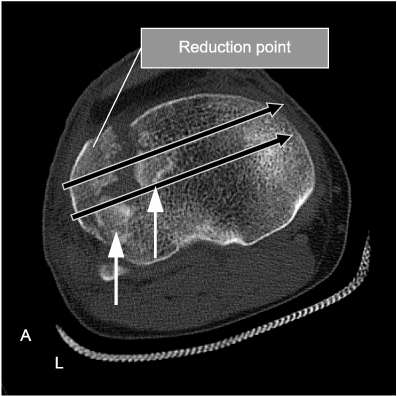
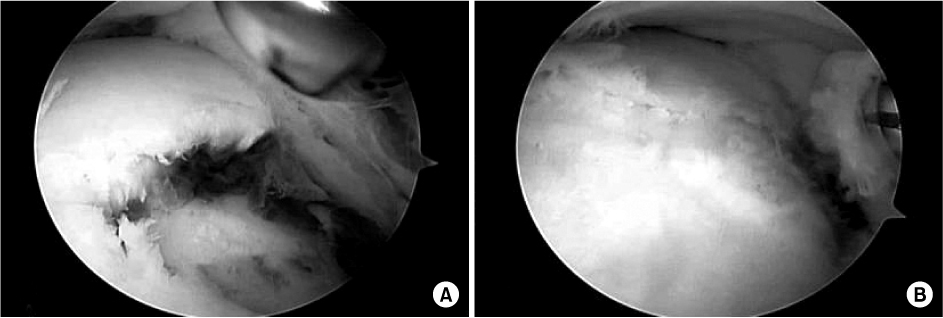
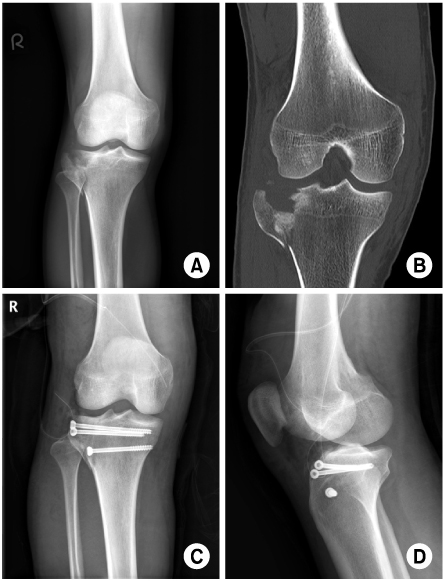
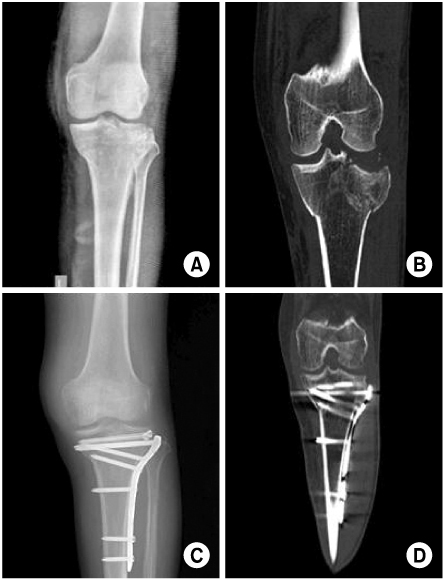
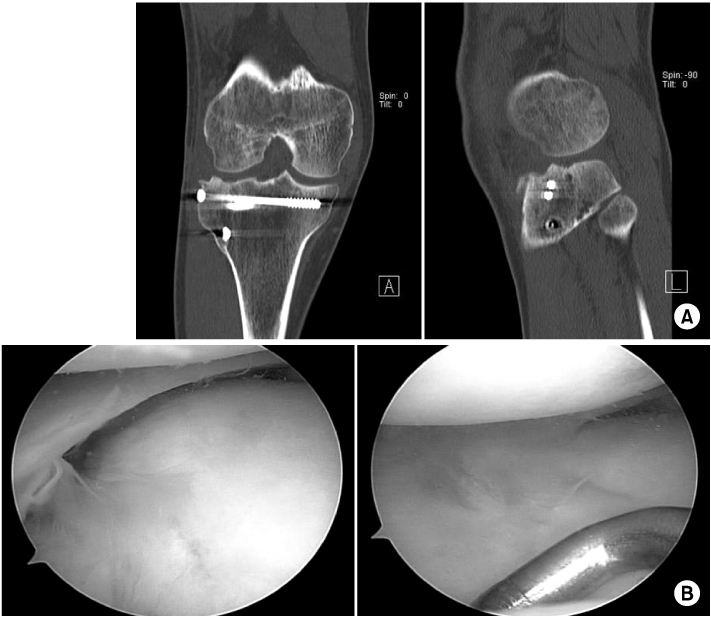
Figure & Data
REFERENCES
Citations

- Current Concepts in Management of Tibia Plateau Fracture
Sang Hak Lee, Kang-Il Kim
Journal of the Korean Fracture Society.2014; 27(3): 245. CrossRef





Fig. 1
Fig. 2
Fig. 3
Fig. 4
Fig. 5
Patient Demographics (N=12)
M: Male, F: Female, LM: Lateral meniscus, MCL: Medial collateral ligament, PCL: Posterior cruciate ligament, MM: Medial meniscus, ACL: Anterior cruciate ligament.
Results (N=12)
M: Male, F: Female, LM: Lateral meniscus, MCL: Medial collateral ligament, PCL: Posterior cruciate ligament, MM: Medial meniscus, ACL: Anterior cruciate ligament.

 E-submission
E-submission KOTA
KOTA TOTA
TOTA TOTS
TOTS
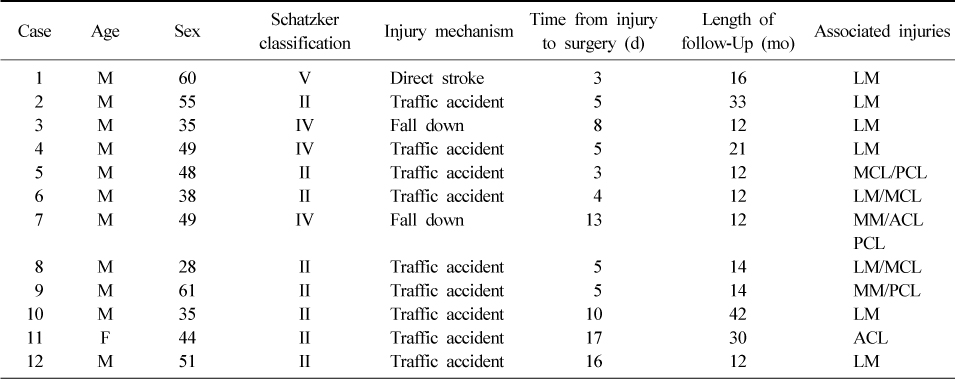
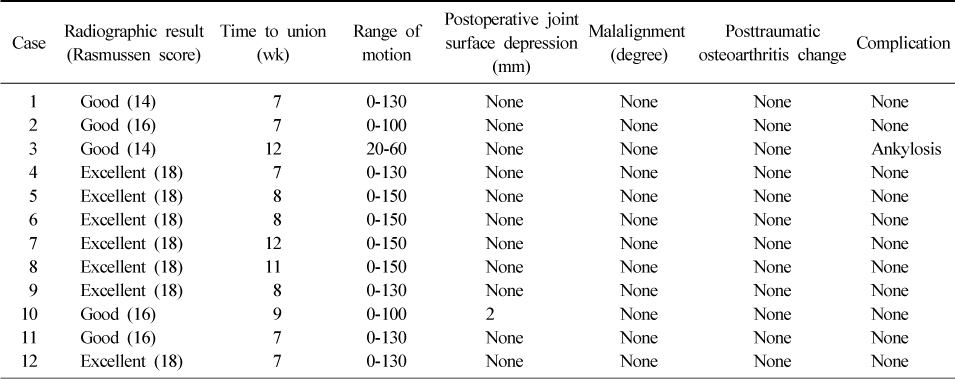
 Cite
Cite

